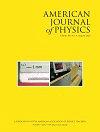Coupled oscillations of the Wilberforce pendulum unveiled by smartphones
IF 0.9
4区 教育学
Q3 EDUCATION, SCIENTIFIC DISCIPLINES
引用次数: 1
Abstract
The Wilberforce pendulum illustrates important properties of coupled oscillators including normal modes and beat phenomena. When helical spring is attached to a mass to create the Wilberforce pendulum, the longitudinal and torsional oscillations are coupled. A Wilberforce can be constructed simply from a standard laboratory spring, and a smartphone's accelerometer and gyroscope can be used to monitor the oscillations. We show that the resulting time-series data match theoretical predictions, and we share the procedures for observing both normal modes and beats.智能手机揭示了威尔伯福斯摆的耦合振荡
威尔伯福斯摆说明了耦合振荡器的重要性质,包括正模态和拍频现象。当螺旋弹簧附着在一个质量上形成威尔伯福斯摆时,纵向和扭转振荡是耦合的。威尔伯福斯可以用一个标准的实验室弹簧简单地构造出来,智能手机的加速度计和陀螺仪可以用来监测振荡。我们证明了得到的时间序列数据与理论预测相匹配,并且我们分享了观察正常模式和节拍的过程。
本文章由计算机程序翻译,如有差异,请以英文原文为准。
求助全文
约1分钟内获得全文
求助全文
来源期刊

American Journal of Physics
物理-物理:综合
CiteScore
1.80
自引率
11.10%
发文量
146
审稿时长
3 months
期刊介绍:
The mission of the American Journal of Physics (AJP) is to publish articles on the educational and cultural aspects of physics that are useful, interesting, and accessible to a diverse audience of physics students, educators, and researchers. Our audience generally reads outside their specialties to broaden their understanding of physics and to expand and enhance their pedagogical toolkits at the undergraduate and graduate levels.
 求助内容:
求助内容: 应助结果提醒方式:
应助结果提醒方式:


